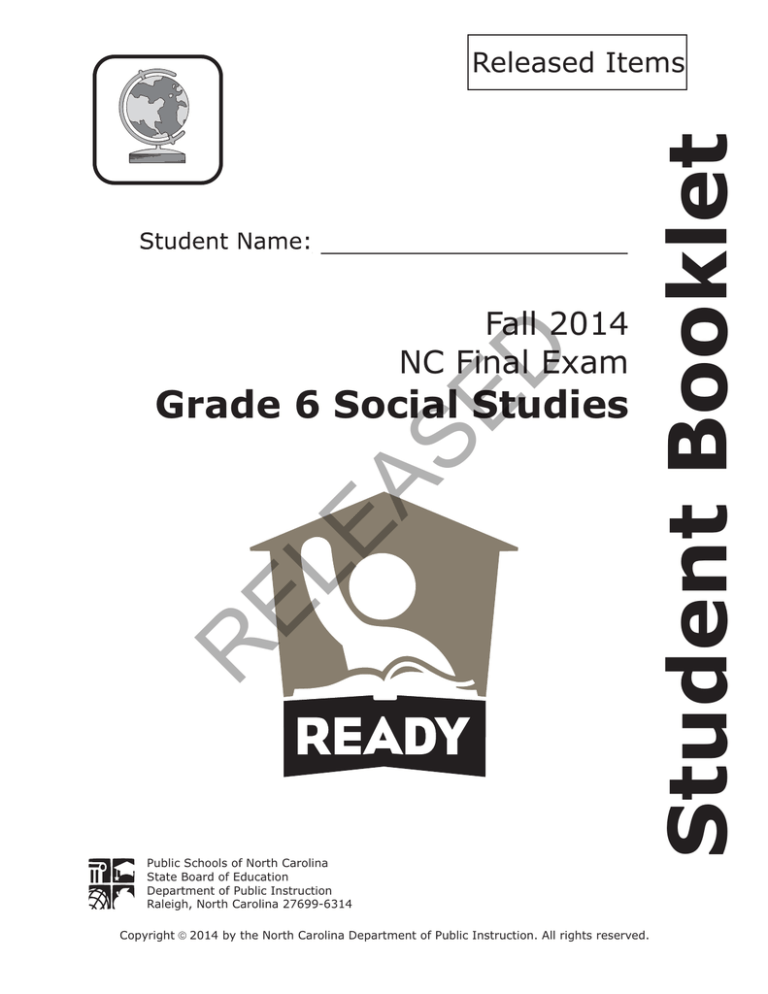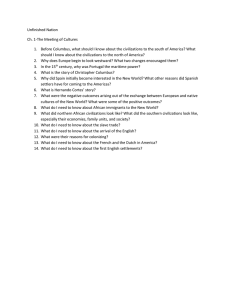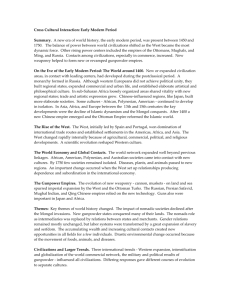
D
Fall 2014
NC Final Exam
R
EL
EA
SE
Grade 6 Social Studies
Public Schools of North Carolina
State Board of Education
Department of Public Instruction
Raleigh, North Carolina 27699-6314
Copyright ã 2014 by the North Carolina Department of Public Instruction. All rights reserved.
Student Booklet
Released Items
GRADE 6 SOCIAL STUDIES — RELEASED ITEMS
A
Innovations made it possible to expand settlements at arid locations.
B
Innovations increased the numbers of hunters and gatherers.
C
Innovations required smaller herds and less livestock.
D
Innovations decreased the size of cities.
SE
D
Legalism: belief that leaders should rule with force
Confucianism: The ruler bears responsibility for the well-being of the people and,
therefore, for peace and order in the empire.
Chinese leaders moved from a legalistic government to a government based on
Confucianism. How did Confucius transform the society?
Government leaders became concerned with the condition of China’s
citizens.
B
Military leaders became more important than educators and priests.
C
Farmers became less dependent on government subsidies and support.
D
Merchants became concerned with the economic issues affecting China’s
citizens.
EA
A
EL
2
How did innovations such as irrigation, aqueducts, and improved farm techniques
transform civilizations?
R
1
1
Go to the next page.
GRADE 6 SOCIAL STUDIES — RELEASED ITEMS
3
In 711 CE, the Moors invaded Spain and established Islamic rule. During this
period, philosophy, mathematics, and science flourished in the nation. For
instance, Ibn Zuhr, a physician and surgeon, tested medical procedures on
animals before using them on humans. His work was translated into Latin and
Hebrew and had a significant impact on the medical field. Spain remained closely
connected to Baghdad for 200 years before becoming independent. Spain was one
of the wealthiest areas of Europe during the period of Moorish rule.
Based on the above passage, how did the Moorish invasion of Spain affect
civilization in the region?
B
It led to the development of new scientific and mathematical techniques.
C
It created an isolated area of economic development and trade.
D
It transformed Spain into a society primarily concerned with military power.
EA
SE
D
It forbade the advancement of philosophy and emphasized religion.
Hammurabi was the King of Babylon from 1792 BCE to 1750 BCE. Hammurabi
wrote The Code of Hammurabi, the oldest set of laws known to exist, which was
made up of 282 laws. The code was carved in stone for all to see and read.
EL
Facts about The Code of Hammurabi
This was the first written code—people could see it. This increased
people’s ability to read.
The code treated women fairly.
R
4
A
The harsh punishments made civilizations safer.
The code reinforced class structure—punishments were different for
the different classes.
Based on the above information, how did Hammurabi help to transform society?
A
His laws got rid of the existing class system.
B
He required that every class be punished equally.
C
He continued the practice of treating women differently from men.
D
His laws were written to include women.
2
Go to the next page.
GRADE 6 SOCIAL STUDIES — RELEASED ITEMS
5
Trade routes linking West Africa and North Africa required the
shipment of goods across the hot, dry Sahara Desert. It was difficult
for the traders to carry these goods along these trade routes.
Domesticated camels were brought to the Sahara. The camels could go
for long stretches without drinking, survive extreme temperatures, and
haul heavy loads.
How did the camels affect the transport of goods across the Sahara Desert?
B
Traders were able to drink the milk from camels during their journey.
C
Camels made travel across the desert more reliable and safer.
D
Camels slowed transport by requiring frequent drinks of water.
The Roman Forum
EA
SE
D
Traders were able to use camels to stop trans-Saharan shipments of goods.
EL
The Roman forum was located at the center of Ancient Rome. It was a gathering
place where public events were held. Soon the forum grew to also include
merchant shops, temples and government buildings. The forum became the
religious, economic, and government center for Rome.
Based on the above information, how did the forum contribute to Roman
civilization?
R
6
A
A
Instead of being solely focused on commerce, the forum also fulfilled cultural
needs of the Romans.
B
The forum provided cheaper prices for Romans than other markets.
C
Government buildings were the focus of the forum, showcasing the power of
the Roman government.
D
Forum ruins still can be found today, because they were so well built.
3
Go to the next page.
GRADE 6 SOCIAL STUDIES — RELEASED ITEMS
As restrictions and prohibitions are multiplied in the Empire, the people grow
poorer and poorer. When the people are subjected to overmuch government, the
land is thrown into confusion . . . . The greater the number of laws and
enactments, the more thieves and robbers there will be. Therefore the Sage says:
“So long as I do nothing, the people will work out their own reformation. So long
as I love calm, the people will right themselves. If only I keep from meddling, the
people will grow rich. If only I am free from desire, the people will come naturally
back to simplicity.”
What were Lao-Tzu’s views on government?
D
The Sayings of Lao-Tzu: Government
Courtesy of the Internet Sacred Text Archive
Lao-Tzu thought that people were naturally evil and needed many laws to
govern their behavior.
B
Lao-Tzu advocated for limited government involvement in people’s everyday
lives.
C
Lao-Tzu believed that only people from the upper class were fit to govern.
D
Lao-Tzu felt that regulations on trade would lead to more people becoming
rich.
EL
EA
SE
A
R
7
4
Go to the next page.
GRADE 6 SOCIAL STUDIES — RELEASED ITEMS
There came from India certain monks . . . they promised the emperor in an
interview that they would provide the materials for making silk so that never
should the Romans seek business of this kind from their enemy the Persians, or
from any other people whatsoever. . . . Thus began the art of making silk from
that time on in the Roman Empire.
“Procopius: The Roman Silk Industry, c. 550,” modernized by Jerome S. Arkenberg
Courtesy of Internet History Sourcebooks Project, http://www.fordham.edu/halsall
How did the negotiations between the Indian monks and the Roman emperor
affect the silk trade in the Roman empire?
The Roman Empire started to import silk from India rather than from Persia.
B
The Indian monks offered to establish a route for silk trade with Persia.
C
The Roman Empire no longer had to import silk because it could be produced
locally.
D
The Persians offered a better price for silk, so the Romans began to trade
with them.
EL
EA
SE
D
A
R
8
5
Go to the next page.
GRADE 6 SOCIAL STUDIES — RELEASED ITEMS
Timeline of Legal Codes
1700 BCE
Hammurabi’s code in Babylon created strict laws and punishments.
550 BCE
Solon’s code in Greece created less strict laws and punishments.
1215 CE
Magna Carta in England limits a king’s power and protects citizens’ rights.
How has the role of legal codes evolved through time in human societies?
Laws have become stricter over time.
B
Legal codes have been based on religious beliefs.
C
Governments have never supported the rights of citizens.
D
Legal codes have gradually given more protections to citizens.
EL
EA
SE
D
A
R
9
6
Go to the next page.
GRADE 6 SOCIAL STUDIES — RELEASED ITEMS
I will sing of well-founded Earth,
Mother of all, eldest of all beings.
She feeds all creatures that are in the world,
All that go upon the goodly land,
And all that are in the paths of the seas,
And all that fly: all these are fed of her store.
Through you, O queen, men are blessed in their children
And blessed in their harvests,
And to you it belongs to give means of life
To mortal men and to take it away.
D
Homer
Which value of Greek civilization is reflected in this hymn?
The Greeks believed that gods and goddesses were involved in natural
events.
B
The Greeks believed that humans became gods and goddesses after death.
C
The Greeks believed that gods and goddesses were at war with humans.
D
The Greeks believed that gods and goddesses needed sacrifices offered by
humans to stay alive.
EL
EA
SE
A
R
10
7
Go to the next page.
GRADE 6 SOCIAL STUDIES — RELEASED ITEMS
This is the end of the Grade 6 Social Studies Released Items.
Directions:
1. Look back over your answers for the test questions.
2. Make sure all your answers are entered on the answer sheet. Only what is
entered on your answer sheet will be scored.
3. Put all of your papers inside your test book and close the test book.
D
4. Stay quietly in your seat until your teacher tells you that testing is
finished.
R
EL
EA
SE
5. Remember, teachers are not allowed to discuss items from the test with
you, and you are not allowed to discuss with others any of the test
questions or information contained within the test.
8
GRADE 6 SOCIAL STUDIES — RELEASED ITEMS
Grade 6 Social Studies
RELEASED Items1
Fall 2014
Answer Key
Type2
Key
1
MC
A
69%
6.H.2.3
2
MC
A
64%
6.H.2.4
3
MC
B
63%
6.H.2.1
4
MC
D
55%
6.H.2.4
5
MC
C
79%
6.G.1.4
6
MC
A
51%
6.G.1.1
7
MC
B
46%
6.C&G.1.2
8
MC
C
38%
6.E.1.1
MC
D
63%
6.C&G.1.4
MC
A
59%
6.C.1.1
SE
EA
Standard
R
10
EL
9
Percent Correct3
D
Item Number
1
These released items were administered to students during a previous test administration. This
sample set of released items may not reflect the breadth of the standards assessed and/or the
range of item difficulty found on the NC Final Exam. Additional items may be reviewed at
http://www.ncpublicschools.org/accountability/common-exams/released-forms/. Additional
information about the NC Final Exam is available in the Assessment Specification for each exam
located at http://www.ncpublicschools.org/accountability/common-exams/specifications/.
2
This NC Final Exam contains only multiple-choice (MC) items.
3
Percent correct is the percentage of students who answered the item correctly during the
Spring 2014 administration.
1
GRADE 6 SOCIAL STUDIES — RELEASED ITEMS
Standard Descriptions
Only clarifying objective descriptions addressed by the released items in this booklet are listed
below. A complete list of the North Carolina Essential Standards for Science and Social Studies
may be reviewed at http://www.ncpublicschools.org/acre/standards/new-standards/.
6.H.2.1
Explain how invasions, conquests, and migrations affected various civilizations, societies and
regions (e.g. Mongol invasion, the Crusades, the Peopling of the Americas and Alexander the
Great).
D
6.H.2.3
Explain how innovation and/or technology transformed civilizations, societies and regions over
time (e.g. agricultural technology, weaponry, transportation and communication).
SE
6.H.2.4
Explain the role that key historical figures and cultural groups had in transforming society
(e.g. Mansa Musa, Confucius, Charlemagne and Qin Shi Huangdi).
EA
6.G.1.1
Explain how the physical features and human characteristics of a place influenced the
development of civilizations, societies and regions (e.g. location near rivers and natural barriers,
trading practices and spread of culture).
EL
6.G.1.4
Explain how and why civilizations, societies and regions have used, modified and adapted to
their environments (e.g. invention of tools, domestication of plants and animals, farming
techniques and creation of dwellings).
R
6.E.1.1
Explain how conflict, compromise, and negotiation over the availability of resources (natural,
human and capital) impacted the economic development of various civilizations, societies and
regions (e.g. competition for scarce resources, unequal distribution of wealth and the emergence
of powerful trading networks).
6.C&G.1.2
Summarize the ideas that shaped political thought in various civilizations, societies and regions
(e.g. divine right, equality, liberty, citizen participation and integration of religious principles).
6.C&G.1.4
Compare the role (e.g. maintain order and enforce societal values and beliefs) and evolution of
laws and legal systems (e.g. need for and changing nature of codified system of laws and
punishment) in various civilizations, societies and regions.
2
GRADE 6 SOCIAL STUDIES — RELEASED ITEMS
R
EL
EA
SE
D
6.C.1.1
Analyze how cultural expressions reflected the values of civilizations, societies and regions
(e.g. oral traditions, art, dance, music, literature, and architecture).
3





